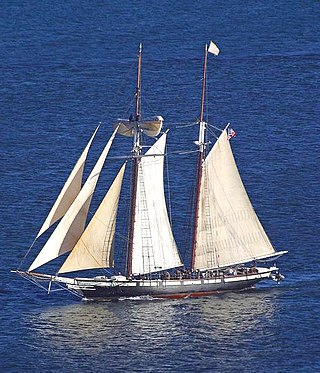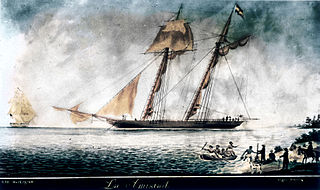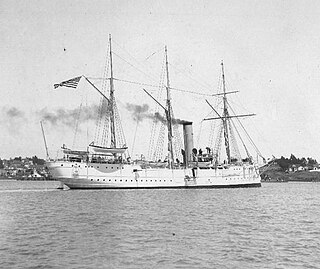
The United States Revenue Cutter Service was established by an act of Congress on 4 August 1790 as the Revenue-Marine upon the recommendation of Secretary of the Treasury Alexander Hamilton to serve as an armed customs enforcement service. As time passed, the service gradually gained missions either voluntarily or by legislation, including those of a military nature. It was generally referred to as the Revenue-Marine until 31 July 1894, when it was officially renamed the Revenue Cutter Service. The Revenue Cutter Service operated under the authority of the U.S. Department of the Treasury. On 28 January 1915, the service was merged by an act of Congress with the United States Life-Saving Service to form the United States Coast Guard.

Harriet Lane was a revenue cutter of the United States Revenue Cutter Service and, on the outbreak of the American Civil War, a ship of the United States Navy and later Confederate States Navy. The craft was named after the niece of senator and later United States President, James Buchanan; during his presidency, she acted as First Lady. The cutter was christened and entered the water for the Revenue Service in 1859 out of New York City, and saw action during the Civil War at Fort Sumter, New Orleans, Galveston, Texas, and Virginia Point. The Confederates captured her in 1863, whereupon she was converted to mercantile service. Union forces recaptured her at the end of war. The U.S. Navy declared her unfit for service and sold her. New owners out of Philadelphia renamed her Elliot Ritchie. Her crew abandoned her at sea in 1881.

Californian is a 1984 replica of the United States Revenue Marine cutter Lawrence, which operated off the coast of California in the 1850s. On July 23, 2003, Governor Arnold Schwarzenegger signed Bill No. 965, making her the "official state tall ship" of California.

Washington was a revenue cutter that served in the United States Revenue Cutter Service and in the United States Navy. She discovered, boarded, and captured La Amistad after the slaves onboard had seized control of that schooner in an 1839 mutiny.

USS McCulloch, previously USRC McCulloch and USCGC McCulloch, was a ship that served as a United States Revenue Cutter Service cutter from 1897 to 1915, as a United States Coast Guard Cutter from 1915 to 1917, and as a United States Navy patrol vessel in 1917. She saw combat during the Spanish–American War during the Battle of Manila Bay and patrolled off the United States West Coast during World War I. In peacetime, she saw extensive service in the waters off the U.S. West Coast. She sank in 1917 after colliding with another steamer.
USRC Walter Forward was a schooner constructed for service with the United States Revenue Marine. She was more commonly known as USRC Forward. Forward served with the U.S. Army and U.S. Navy in Mexican waters during the Mexican–American War and was commended for her actions during the Tabasco River landings by Commodore Matthew C. Perry, U.S. Navy. After the war, she was transferred to the U.S. Coast Survey for a short time as USCS Walter Forward before being returned to the Revenue Marine for service during the 1850s and the American Civil War.

The United States Coast and Geodetic Survey, known from 1807 to 1836 as the Survey of the Coast and from 1836 until 1878 as the United States Coast Survey, was the first scientific agency of the United States Government. It existed from 1807 to 1970, and throughout its history was responsible for mapping and charting the coast of the United States, and later the coasts of U.S. territories. In 1871, it gained the additional responsibility of surveying the interior of the United States and geodesy became a more important part of its work, leading to it being renamed the U.S. Coast and Geodetic Survey in 1878.

USRC Manning was a revenue cutter of the United States Revenue Cutter Service that served from 1898 to 1930, and saw service in the U.S. Navy in the Spanish–American War and World War I.

Active was a survey ship that served in the United States Coast Survey, a predecessor of the United States Coast and Geodetic Survey, from 1852 to 1861. Active served on the U.S. West Coast. She conducted the Coast Survey's first reconnaissance from San Francisco, California, to San Diego, California, in 1852. Active sometimes stepped outside her normal Coast Survey duties to support U.S. military operations, serving as a troop transport and dispatch boat during various wars with Native Americans and during the San Juan Islands "Pig War" with the United Kingdom in 1859. She also rushed Union troops to Los Angeles, California, in 1861 during the early stages of the American Civil War.

USCS Robert J. Walker was a survey ship that served in the United States Coast Survey, a predecessor of the United States Coast and Geodetic Survey, from 1848 until sinking in 1860 after a collision at sea. Her loss resulted in the death of 20 men, the greatest loss of life in single incident ever to befall the National Oceanic and Atmospheric Administration or any of its ancestor agencies. It was added to the National Register of Historic Places on March 19, 2014.
USS Jefferson may refer to the following ships operated by the United States:

USRC Tahoma, was a steel-hull flush deck cutter that served in the United States Revenue Cutter Service from 1909 to 1914 with the Bering Sea Patrol and was the sister ship to the USRC Yamacraw.
USRC Richard Rush was a Dexter-class cutter of the United States Revenue Cutter Service which served in the coastal waters of the western United States and the Department of Alaska.
USRC Kewanee was a Pawtuxet-class screw steam revenue cutter built for the United States Revenue Marine during the American Civil War.

USRC Wayanda was a Pawtuxet-class screw steam revenue cutter built for the United States Revenue Cutter Service during the American Civil War.
The revenue cutter George M. Bibb was an iron-hulled steamboat built at Pittsburgh in 1845, named after the then-Secretary of the Treasury George M. Bibb, which served on blockade duty during the war with Mexico in 1846, and was transferred to the U.S. Coast Survey in 1847. Its engines were salvaged for a second Bibb that is sometimes considered to be a rebuild of the George M. Bibb.
Captain Alexander V. Fraser, U. S. Revenue Marine, was an American seaman, who served as the first Chief of the Revenue Marine Bureau, Department of the Treasury, one of the predecessor agencies of the United States Coast Guard.

Senator was a wooden, side-wheel steamship built in New York in 1848. She was one of the first steamships on the California coast and arguably one of the most commercially successful, arriving in San Francisco at the height of the California gold rush. She was the first ocean-going steamer to sail up the Sacramento River to reach the new gold fields. After more purpose-built river steamers became available, Senator began a 26-year long career sailing between San Francisco and Southern California ports. Age and improving technology finally made the ship unsuitable for passenger service by 1882. Her machinery was removed and she was converted into a coal hulk. She ended her days in New Zealand, where she was broken up sometime around 1912.
USRC Harrison was the lead ship of her topsail schooner class, which was built and operated by the United States Revenue-Marine, later Revenue Cutter Service, between 1849 and 1856.
USRC Ingham was the second ship of the Harrison schooner class, which was built and operated by the United States Revenue Cutter Service between 1849 and 1856. She is the third ship of the Revenue Cutter Service to bear the name.












